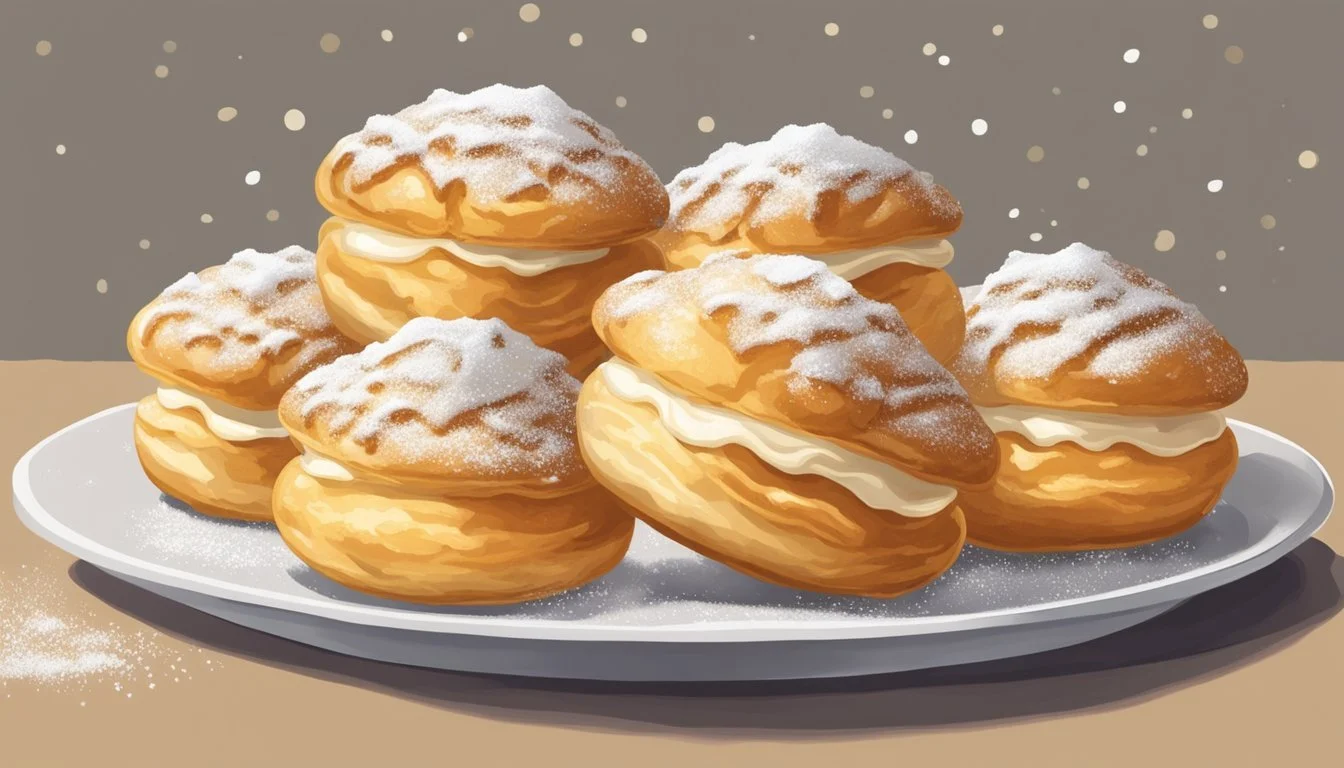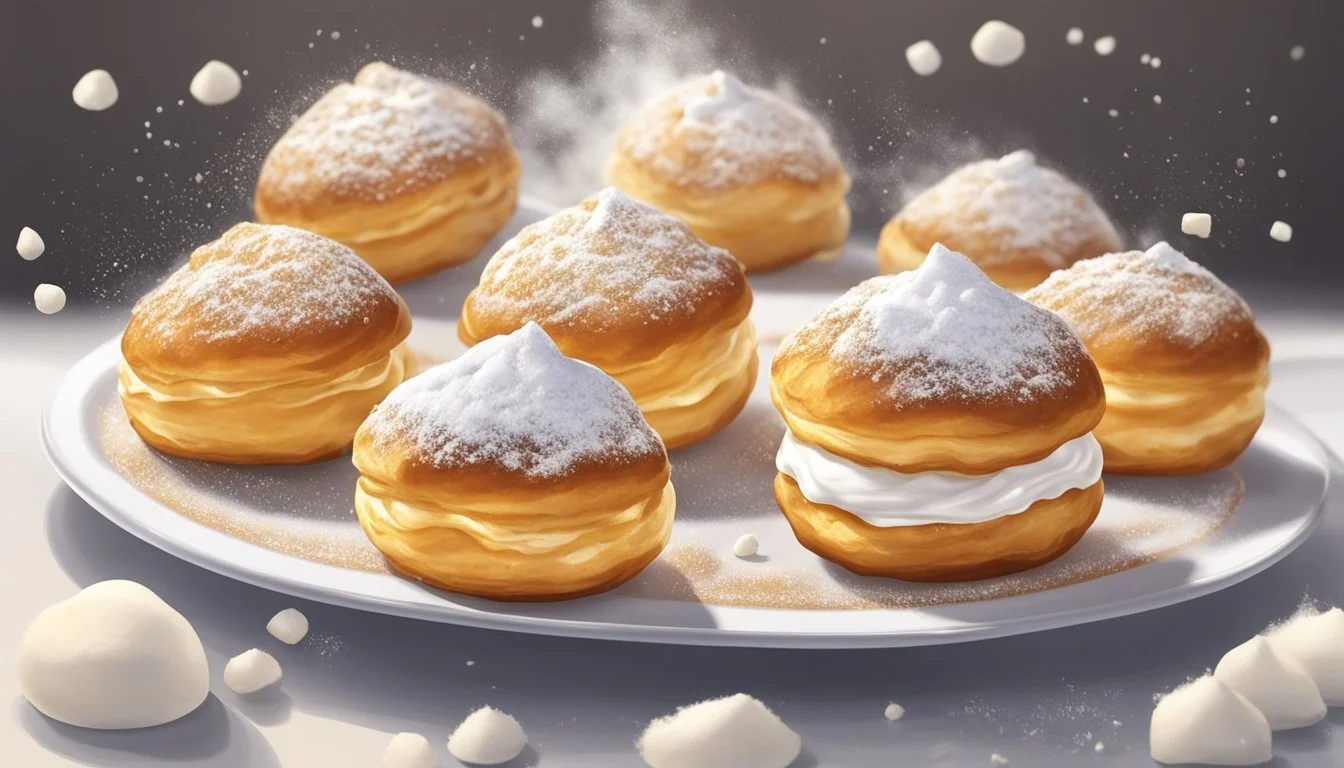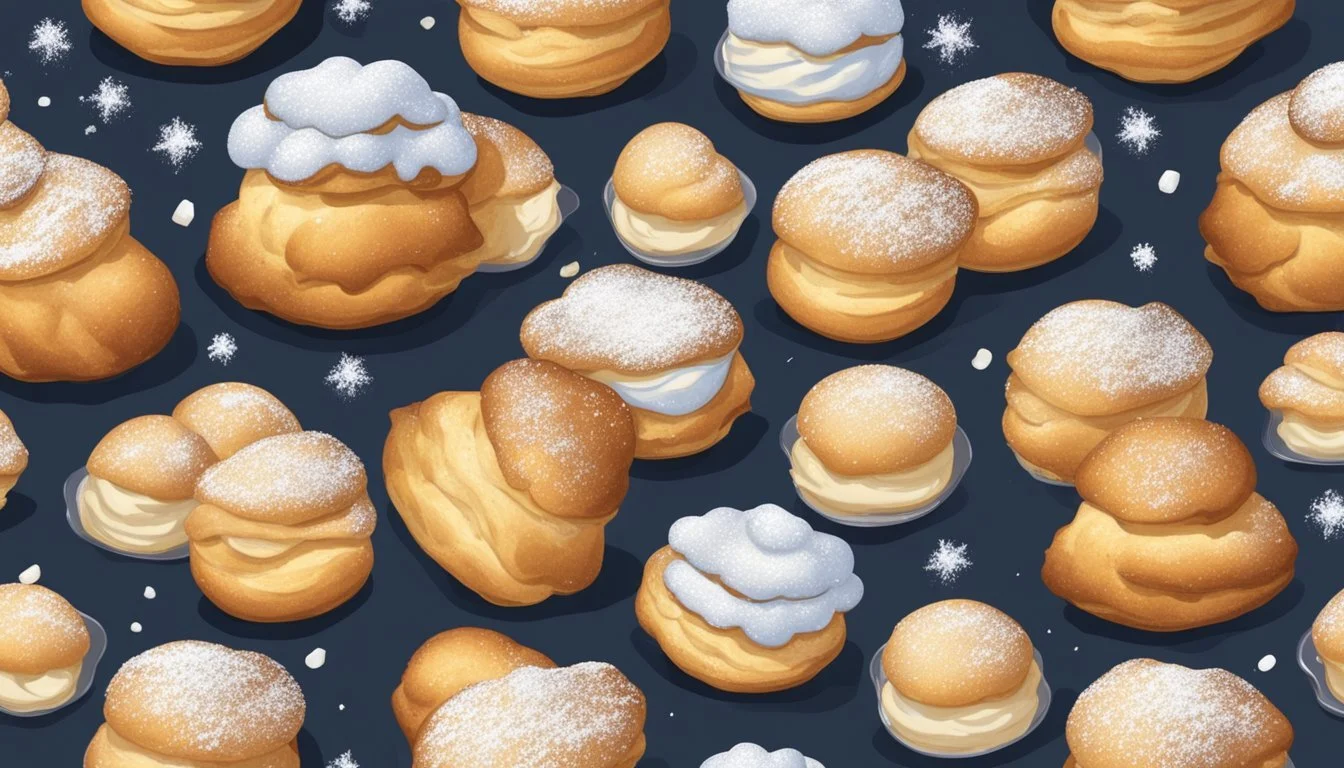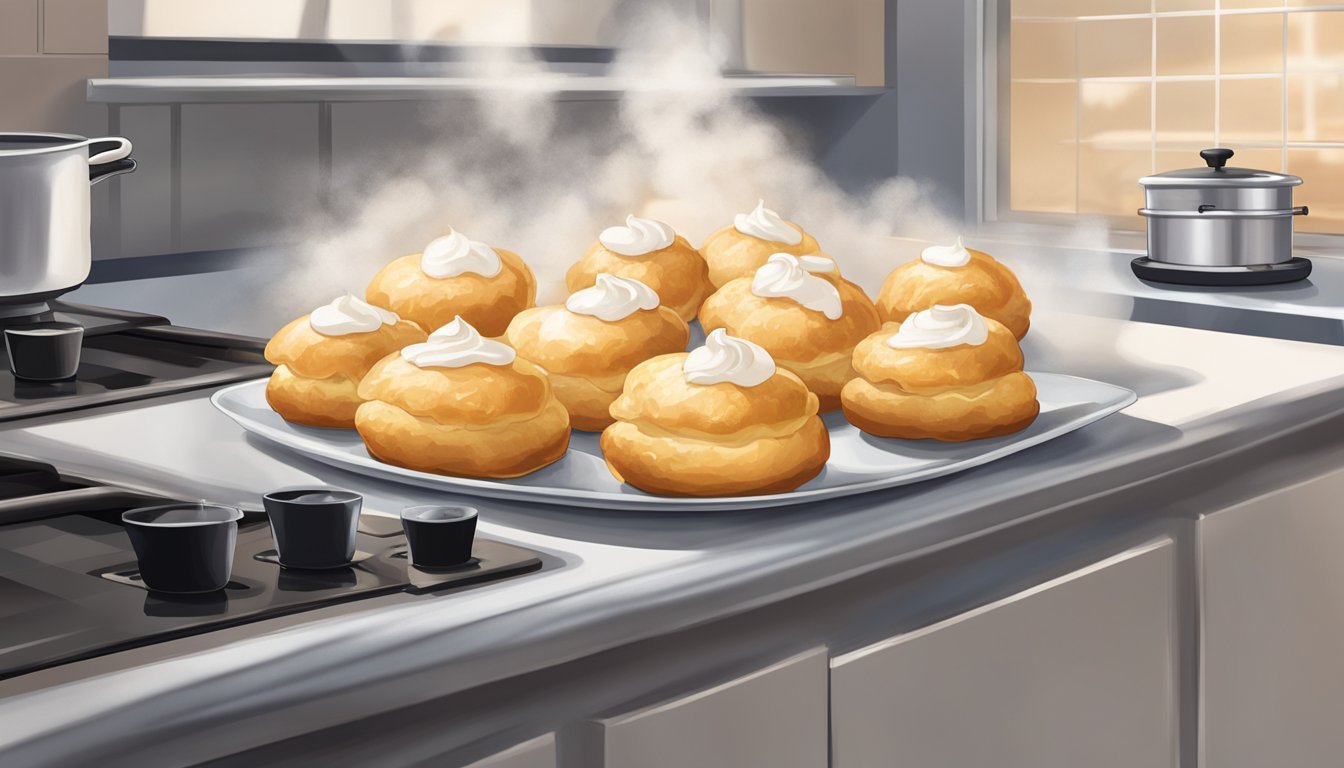How Long Do Freshly Prepared Cream Puffs Last?
Shelf Life and Storage Tips
Cream puffs, a delicate and airy pastry known for their crisp exterior and lush cream (how long does cream last?) filling, are a prized dessert for many. However, their prime doesn't last indefinitely, as the pastry's condition is heavily influenced by storage conditions and time. Ideally, these exquisite confections should be consumed within hours of preparation to ensure the enjoyment of their signature textural contrast between the moist filling and the flaky crust.
When preservation is necessary, the shelf life of cream puffs varies depending on whether they are stored in the refrigerator or freezer and whether they are filled or unfilled. Unfilled cream puff shells can be kept crisp for up to 24 hours in the refrigerator if stored in an airtight container, preventing them from absorbing moisture which leads to sogginess. For extended storage, freezing can maintain their quality for up to two months, ensuring that these puffs retain their structure until they're ready to be enjoyed.
Essentials of Cream Puff Composition
Creating perfect cream puffs requires meticulous attention to the ingredients used in their composition as well as understanding the pivotal role played by choux pastry. Ingredients are carefully measured to ensure a balanced texture and flavor, with each component serving a distinct purpose in the creation of this delicate dessert.
Ingredients for Cream Puffs
The foundation for cream puffs is a dough known as choux pastry, made from fundamental ingredients that must be of high quality for the best results:
Butter: A key ingredient that adds flavor and aids in the rising of the pastry.
Water and/or Milk: Liquids are essential to create the dough. Some recipes use a mixture of both for a richer taste.
Flour: Provides the structure to the pastry shells; it’s combined with the butter and water/milk to form a roux.
Egg: Eggs are incorporated to give the pastry a light, airy texture once it bakes.
Salt: A small amount is often used to enhance the overall flavor of the pastry.
The ingredients are mixed in a specific order to achieve the correct consistency for piping and baking.
The Role of Choux Pastry in Cream Puffs
Choux pastry is unique among pastries with its use of steam as a leavening agent. During the baking process, the high moisture content of the dough turns to steam, puffing the pastry into hollow rounds perfect for filling.
Technique: The choux pastry must be cooked until it reaches a stage where it can hold its shape, yet is pliable enough to pipe into small mounds on a baking sheet.
Bake: A high initial oven temperature is critical, usually around 400 degrees F, for the pastry to rise properly and become hollow, light, and golden brown.
Filling: Once cooled, the pastry shells are typically filled with whipped cream or sweetened pastry cream, sometimes a custard, which provides a rich, creamy contrast to the crisp shell.
Final Texture: The cream or custard filling should be smooth and velvety, able to hold its form when piped into the cooled pastry shells.
Creating cream puffs involves balancing ingredients and technique, with choux pastry playing the central role in achieving the signature puffed appearance and delicate texture of the final dessert.
Storing Cream Puffs
Proper storage is essential to maintaining the texture and freshness of cream puffs. They can be refrigerated for short-term storage or frozen for longevity, always using airtight containers to minimize moisture exposure and prevent staleness.
Refrigeration Method
Cream puffs should be placed in an airtight container after they have completely cooled to room temperature. In the refrigerator, these containers help prevent condensation from forming, which can make the puffs soggy. The refrigerator is suitable for keeping cream puffs fresh for up to 24 hours.
Steps to refrigerate:
Allow puffs to cool after baking.
Store in an airtight container.
Place in the fridge to prevent staleness.
Room Temperature Storage
Storing the puffs at room temperature is suitable only when they will be consumed within a few hours. Puffs should be kept on a baking sheet and covered with a piece of plastic wrap to protect them from dust and other contaminants.
Important consideration:
Do not leave puffs out for extended periods as they are prone to becoming stale due to exposure to air.
Freezing Cream Puffs
For long-term storage, freezing cream puffs is the most effective method. The process involves wrapping them in plastic wrap and then placing them in airtight containers or freezer bags. When stored in the freezer, cream puffs can last up to two months.
Freezing and thawing instructions:
Wrap each puff individually in plastic wrap.
Place wrapped puffs in an airtight container or freezer bag.
To thaw, remove from the freezer and allow to come to room temperature before unwrapping to avoid condensation build-up.
Extending Shelf Life
To maintain the freshness and texture of cream puffs, one must manage several factors, with humidity being a critical element to control. Cream puffs stored in a humid environment may become soggy, compromising their quality.
Airtight Containers: Placing cream puffs in an airtight container is essential because it minimizes exposure to air and humidity. This encapsulation helps retain their crisp texture significantly longer.
Storage Location Expected Shelf Life Airtight at room temperature A few hours post-baking Airtight in the refrigerator Up to 24 hours Airtight in the freezer Up to two months
Temperature Regulation: Refrigeration can extend the shelf life to 24 hours, allowing for a balance between freshness and the prevention of mold development. However, this can introduce moisture, so the airtight measures should be stringent. Freezing offers an even more extended preservation timeline, albeit with a potential change in texture upon thawing.
Filling Separately: To safeguard the pastry's crispness, it is advised to store the shell and filling separately. One should only fill the cream puffs shortly before serving to ensure optimal texture and prevent them from becoming soggy.
By following these guidelines, the chances of extending the shelf life of cream puffs while maintaining their freshness and texture are greatly improved.
Cream Puffs Serving and Presentation
When serving cream puffs, it's crucial to balance the textures and flavors for the best experience. Presentation enhances not just the visual appeal but can also prevent the pastry from becoming soggy.
Preparation for Serving
The key to maintaining the crispiness of cream puff shells lies in timing. One should fill them with whipped cream or other fillings shortly before serving, as prolonged storage can lead to moisture from the filling softening the pastry. For optimum texture, the fillings should be chilled and the cream puffs assembled, allowing them to stand for just a few minutes prior to service.
Decorating and Enhancing Flavors
Enhancements should complement the delicate, airy nature of cream puffs. A dusting of powdered sugar adds a subtle sweetness and a bakery-worthy finish. For more richness, a drizzle of chocolate ganache or caramel adds both flavor and an elegant appearance. One can also introduce bright notes both visually and in taste with a dollop of jam, fresh berries, or fruit atop or alongside the cream puff. This not only adds color but also layers flavors and textures, making each bite exciting. The artistic addition of an icing or glaze should be light to avoid overpowering the dessert's signature lightness.
Best Practices for Baking Cream Puffs
Achieving the ideal cream puff requires precision in baking techniques and a mastery of pastry shaping. Here, readers will discover key steps for a perfect puff every time.
Baking Techniques
When baking cream puffs, one must ensure the oven is properly preheated to the right temperature. Most recipes call for an oven temperature around 425°F (218°C), a crucial factor in achieving the right puff. It is also important to line the baking sheets with parchment paper, which prevents sticking and helps in even heat distribution.
Preparation Step-by-Step:
Preheat the oven as directed by your recipe, commonly at 425°F.
Line baking sheets with parchment paper to ensure the pastry does not stick.
Baking time is another key aspect. Cream puffs usually start at a high temperature to expand the dough quickly, and then the temperature is lowered to let them dry out and turn golden brown without burning. It is essential to not open the oven during the initial baking period to prevent the puffs from collapsing.
Oven Settings:
Bake initially at a high temperature.
Reduce the oven temperature after the initial expansion phase.
Keep the oven door closed to prevent puffs from deflating.
Creating the Perfect Pastry Shape
The shape of pastry shells is critical to the final presentation and texture of cream puffs. To create uniform shells, a pastry bag is indispensable. One should fill the pastry bag with the batter and pipe it onto the baking sheet, maintaining consistent pressure to form smooth rounds.
Piping Technique:
Fill a pastry bag with the puff batter.
Pipe onto the parchment-lined baking sheets, forming 1 1/2 inch rounds (or as per recipe instructions).
Ensuring that the batter is piped at a distance from each other on the baking sheet is necessary to give room for the puffs to expand without merging into each other. Uniformly sized and spaced puffs will bake more evenly.
Pastry Bag Tips:
Use a large round tip for a classic shape.
Space the rounds adequately to allow for expansion.
Employing these careful techniques will result in cream puffs with a golden exterior and hollow interior, ready to be filled with a sweet or savory cream.
Serving Fresh Cream Puffs
Fresh cream puffs, known for their light and airy pastry, are best served soon after they are made. Timing and proper handling are paramount to maintain their signature texture and flavor.
Optimal Timing for Freshness
The optimal time to serve cream puffs is within a few hours of their preparation. Once filled, the moisture from the filling, which can range from whipped cream or pastry cream to custard, pudding, or jam, begins to soften the crisp pastry. If one must prolong freshness, unfilled shells can be stored in an airtight container:
Freeze: For extended freshness, freeze the pastry shells for up to two months. Place parchment paper between layers to prevent sticking.
Fridge: To store shorter term, refrigerate filled cream puffs for up to 24 hours, though the texture may not be as crisp as when fresh.
Handling Filled Cream Puffs
When filled, cream puffs should be handled with care to preserve their shape and delicate structure. Filling options like custard, ice cream, or pudding should be chilled before incorporating to prevent premature softening of the pastry. It is recommended to fill cream puffs close to serving time to ensure they retain their textural integrity:
Avoid leaving filled cream puffs at room temperature for more than a couple of hours.
Use a piping bag for a clean and even distribution of the filling.
Serve immediately or chill briefly in the refrigerator if necessary, but be mindful that extended refrigeration can affect texture.
Thawing and Reheating Techniques
When dealing with frozen cream puffs, careful thawing and reheating are crucial to maintain their texture and flavor. This section provides specific methods to ensure they are returned to a state nearly as delightful as when they were fresh.
Safely Thawing Frozen Cream Puffs
Thawing Suggestions:
In Refrigerator: Transfer the cream puffs from the freezer to the refrigerator and let them thaw slowly, preferably overnight or for at least 6-8 hours. This gradual process prevents the puffs from becoming mushy.
At Room Temperature: If time-constrained, thaw cream puffs at room temperature, which generally takes about five to ten minutes. Ensure that they are placed in a single layer to allow even thawing.
Reheating Without Compromising Texture
Reheating Guidelines:
In Oven:
Preheat the oven to 350°F (175°C).
Place the unfilled cream puffs on a parchment-lined baking sheet.
Reheat for about 5-10 minutes, until thoroughly warm.
Caution with Microwave: It’s generally not recommended to use a microwave for reheating cream puffs, as it can unevenly heat and potentially ruin their texture.
By following these procedures, reheated cream puffs can be enjoyed with a texture and warmth reminiscent of when they were first baked, providing they are not already filled. Filled cream puffs should typically be consumed when fresh and not subjected to freezing and reheating.
Avoiding Common Pitfalls
When storing cream puffs, there are several factors to consider to maintain freshness and prevent texture loss. The primary concerns are avoiding sogginess and mold growth, which can quickly compromise both the taste and safety of the dessert.
Humidity and Condensation: Cream puffs are best kept in an environment that minimizes humidity to prevent them from becoming soggy. An airtight container is essential to shield them from moisture. Additionally, allowing cream puffs to cool completely before storage prevents condensation from forming within the container.
Do Don't Store in an airtight container Leave them exposed to open air Let cool completely before storing Store while still warm causing condensation Separate with a sheet of baking paper Allow the puffs to touch and stick together
Texture Preservation: To maintain the cream puff's crispiness, it's crucial to freeze them if not consumed within 24 hours. Initial freezing on a baking sheet can preserve their shape before transferring them to a container.
Mold Prevention: Freshness is also about safety; eating cream puffs beyond their optimal storage time risks mold development. Even in the refrigerator, cream puffs should not be stored for more than 48-72 hours to ensure they remain safe to consume.
By adhering to these storage guidelines, one can minimize the risks of sogginess and mold, thereby enjoying cream puffs at their best quality for a limited time post-preparation.
Culinary Context and Variations
Cream puffs are a staple in French pastry, known for their delicate choux pastry and rich filling. From their classic form to inventive reinterpretations, cream puffs show versatility in the world of desserts (What wine goes well with desserts?).
Cream Puffs in French Pastry
The quintessential cream puff, or profiterole, is a French dessert with a history as rich as its pastry cream filling. It begins with pâte à choux, an airy pastry dough made from butter, flour, salt, and water. When baked, the high moisture content creates steam, causing the dough to puff and leave a hollow center that's typically filled with custard or pastry cream.
Variations of Cream Puffs
While the traditional profiterole is filled with sweetened cream, the versatility of cream puffs has led to numerous variants.
Éclairs: An elongated version, filled with cream and topped with fondant icing.
Fillings: Options extend beyond the classic vanilla pastry cream to include chocolate, fruit, caramel, and more.
Toppings: Additional toppings such as powdered sugar, chocolate drizzle, or caramel add another layer of flavor and texture.
Size and Shape: From bite-sized to large, and from round to oblong, cream puffs offer a variety of serving options suitable for different occasions.
By expanding on the traditional recipe, chefs and bakers around the world continue to honor and enhance the legacy of French pastry through cream puffs.
Tips for Homemade Cream Puffs
To achieve the best results with homemade cream puffs, one should focus on selecting quality ingredients and mastering the necessary techniques. These two aspects are critical to creating a successful batch of light, airy puffs with rich, satisfying filling.
Ingredients Selection
When preparing cream puffs at home, the ingredients play a pivotal role. For the pâte à choux, the base of the cream puffs, choose high moisture content butter and fresh eggs, as they contribute to a better rise and richer flavor. Sifted flour prevents lumps in the dough, ensuring a smooth pastry. For the pastry cream, use fresh milk or cream and real vanilla; these impact the cream's luxurious taste and consistency.
Table of Preferred Ingredients:
Ingredient Quality Indicator Butter High moisture content Eggs Freshness Flour Sift prior to use Milk/Cream Freshness Vanilla Pure extract or bean
Techniques for the Home Baker
Proper technique when making cream puffs can greatly affect the end product. For the pâte à choux, ensure that the dough is dry enough before adding eggs so it can puff effectively in the oven. When it comes to filling, it's advisable to use a pastry bag for a neat and uniform appearance. After baking, cool the cream puffs on a rack to prevent humidity from softening the crisp exterior. For storage, cream puffs should be kept airtight to maintain freshness, and they may be wrapped in aluminum foil if freezing is required. Use a skewer to poke a small hole in the bottom of each puff to release steam and prevent sogginess.
Key Techniques Checklist:
Dry the pâte à choux adequately before adding eggs.
Use a pastry bag for an even and professional fill.
Use cooling racks to prevent sogginess post-baking.
Store in airtight containers or wrap securely with aluminum foil for freezing.











